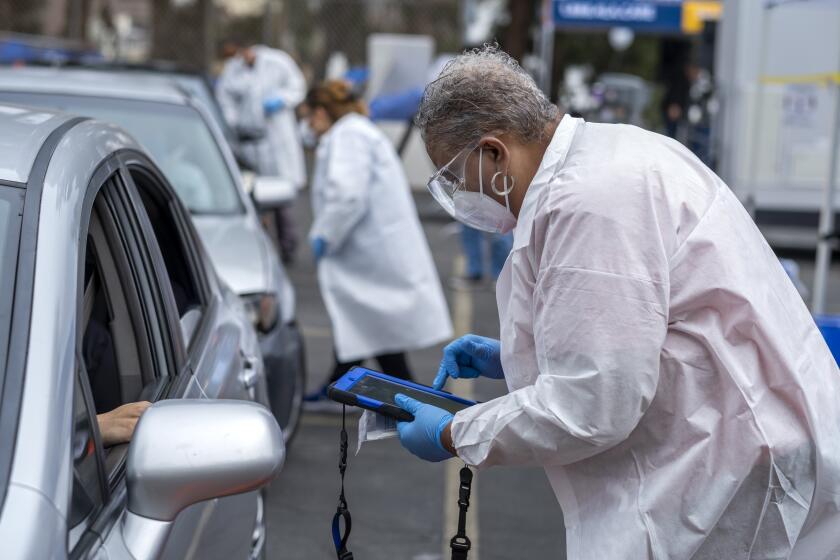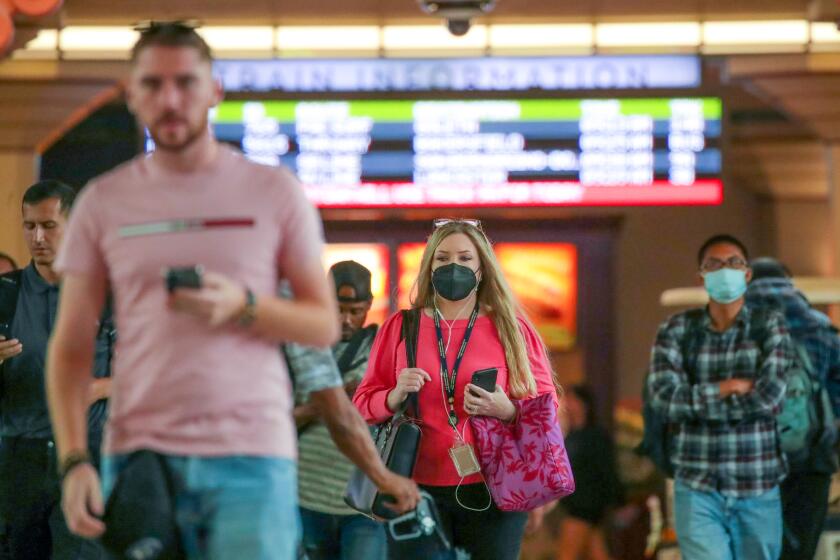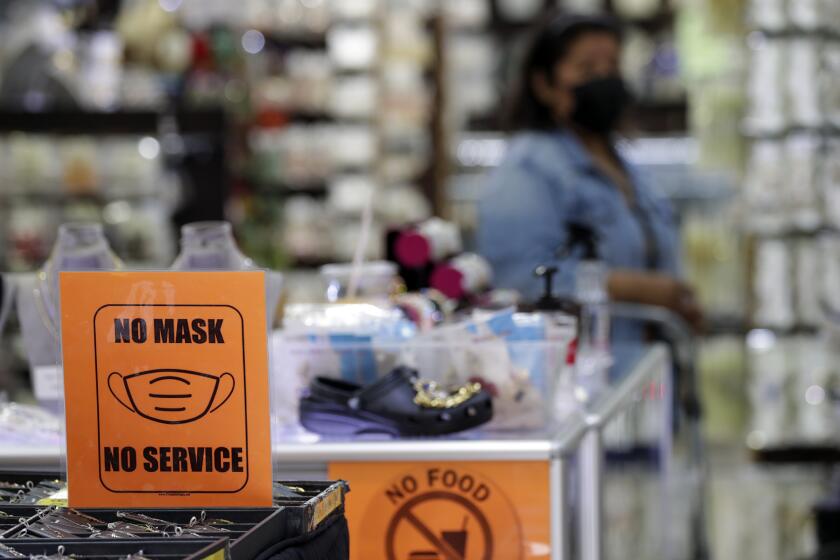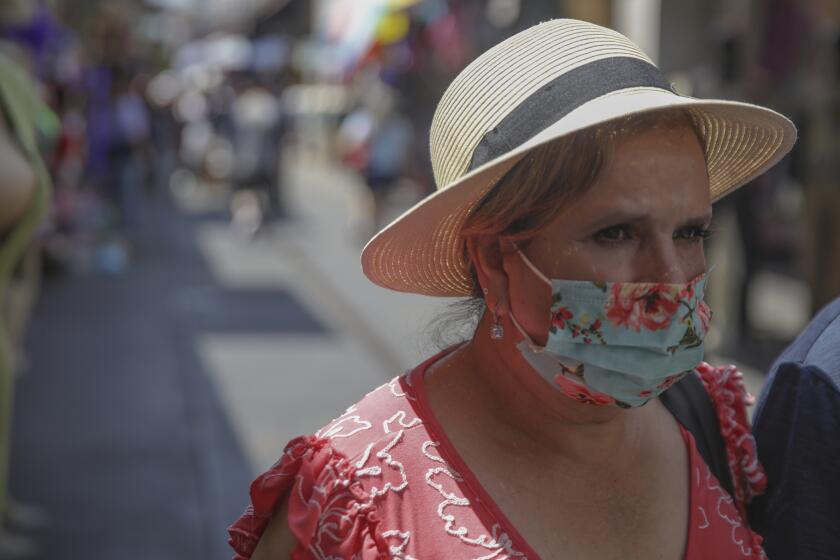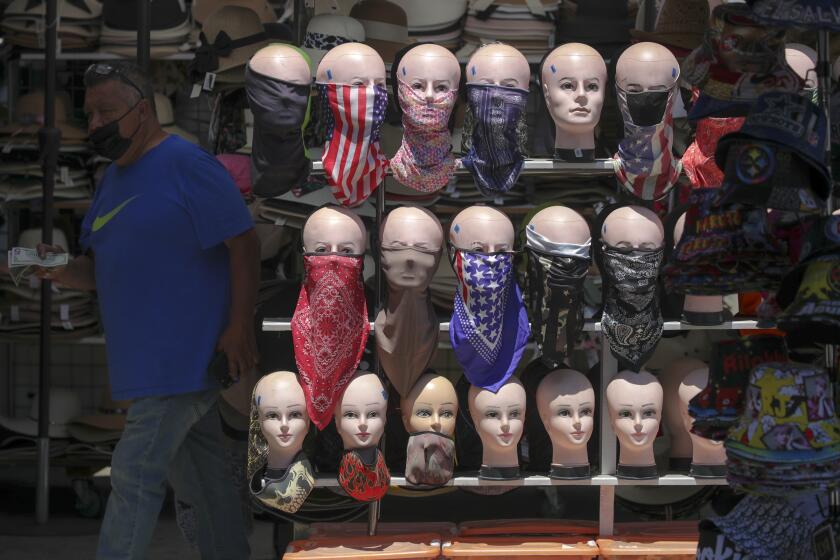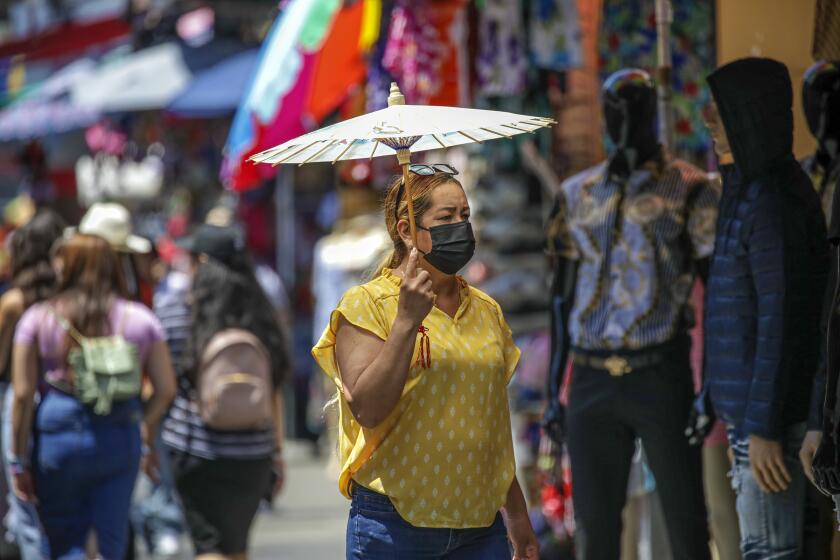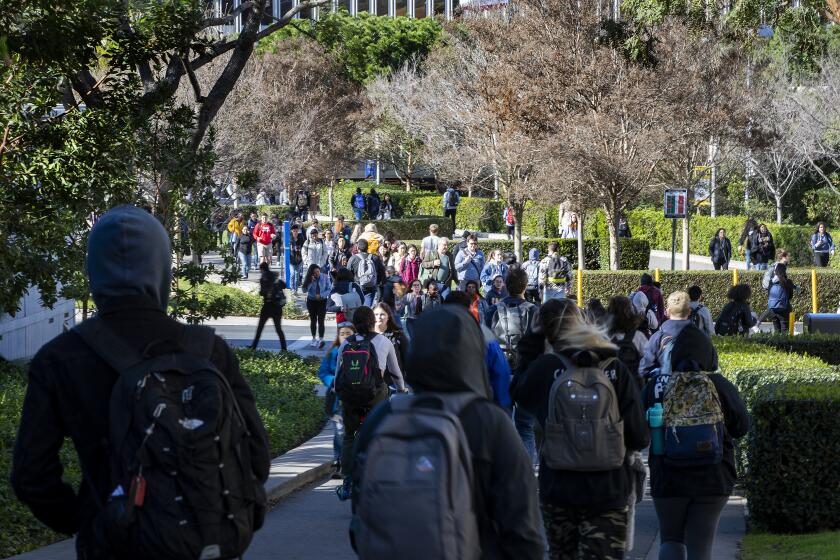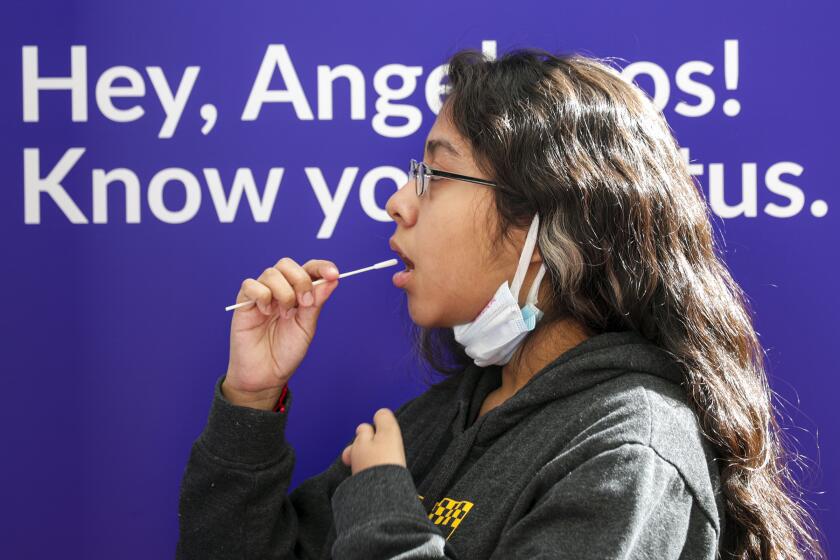Coronavirus cases are soaring in L.A. County, but this wave is different
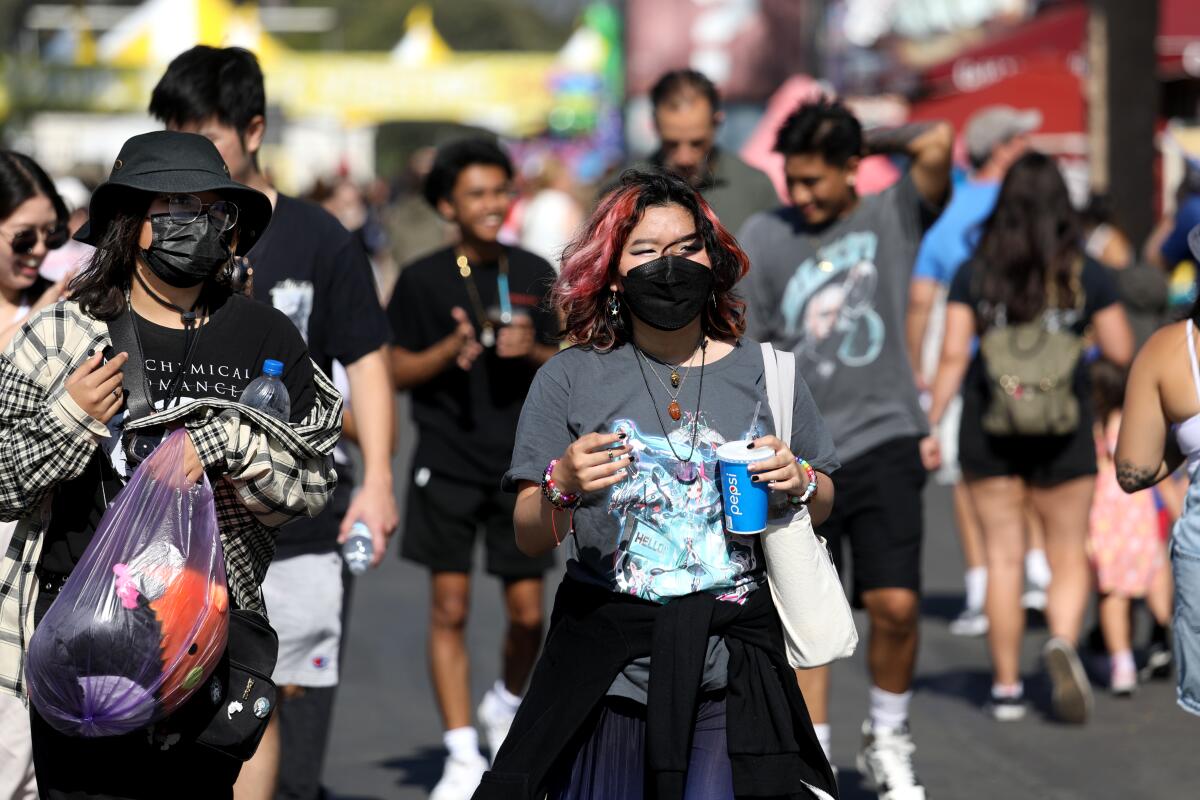
- Share via
Super-contagious Omicron subvariants that can reinfect people within weeks are fueling a new wave of the pandemic across California.
Hospitalizations are rising, and Los Angeles County is moving toward an indoor mask mandate, perhaps by the end of the month.
But this wave is different from previous ones.
Many who become infected are not falling seriously ill. While hospitalizations are rising, patients are generally less sick, and intensive care units are less crowded than during the peaks of previous waves.
Experts cite the availability of vaccines and treatments, as well as changes with the virus itself, for the improvements.
But it doesn’t mean COVID-19 has become a toothless tiger. Deaths in L.A. County have increased significantly over the past month, and so has the number of coronavirus-positive patients in intensive care, which has reached the same level as almost exactly one year ago, the last time L.A. County enacted an indoor mask mandate.
This double-edged reality — where the risk of severe illness for every case may be lower, yet there are considerable numbers of deaths — is causing confusion as the pandemic stretches into its third summer.
The latest kerfuffle stems from the Los Angeles County-USC Medical Center, the largest of four county-run public hospitals. During an internal town hall Wednesday, which was posted online, Chief Medical Officer Dr. Brad Spellberg noted that while coronavirus-positive cases have risen, “this isn’t because we’re seeing a ton of people with symptomatic disease getting admitted.”
Despite the latest surge in coronavirus cases, the impact on hospitals has been relatively minor and COVID-19 deaths have remained fairly low and stable.
Spellberg said around 90% of the hospital’s coronavirus-positive patients were admitted for other issues.
“Virtually none of them go to the ICU — and when they do go to the ICU, it is not for pneumonia. They are not intubated,” he said, citing other issues such as electrolyte abnormalities.
“It is just not the same pandemic as it was, despite all the media hype to the contrary. ... A lot of people have bad colds, is what we’re seeing.”
Epidemiologist Dr. Paul Holtom chimed in that, as of Wednesday, “we have no one in the hospital who had pulmonary disease due to COVID.”
Holtom noted the possibility of a mask mandate but said “there’s no reason, from a hospitalization-due-to-COVID perspective, to be worried at this point.”
If the county remains at the high community level for the next two weeks, a new masking order would be issued, with an effective date of July 29.
As video from the town hall spread online, some highlighted the pair’s remarks to repudiate the concept of a masking order — or to argue that dangers associated with the current coronavirus wave are overstated or unfounded.
But in a statement to The Times on Monday, the L.A. County Department of Health Services, which has oversight of County-USC, said the pandemic “remains a very serious public health threat that we must continue to fight with every tool available, including vaccines, masking, social distancing, and treatment.
“To use our weekly internal town hall to suggest such measures are unnecessary is fundamentally contrary to our position as a medical center,” the statement continued.
While it’s true that many coronavirus-positive patients are not presenting with serious symptoms that require admission to the ICU, the Department of Health Services credited that trend in part to the high level of vaccination coverage in L.A. County.
“While we are not currently experiencing an increase in ICU admissions at [County-USC], we are seeing a significant increase in the number of infections among our patients, staff and the communities we serve,” officials wrote in the statement. “Rising rates of infection are extremely concerning, as the more people who become infected, the greater the probability that ICU admissions for COVID-19 will rise in the future.”
Wastewater data suggest many at-home tests showing infections aren’t being recorded in officially reported coronavirus case counts.
While not as severely as in previous surges, hospitalizations have swelled. In L.A. County, 1,299 coronavirus-positive patients were hospitalized as of Monday — up 60% since the start of the month.
And County-USC’s experience in its ICU may not be representative of L.A. County as a whole. There were 137 coronavirus-positive patients in L.A. County’s intensive care units Monday, far below the highs of previous waves but an increase of almost 51% since July 1. The last time L.A. County enacted an indoor mask mandate, on July 17, 2021, there were 134 coronavirus-positive patients in ICUs.
At the end of June, roughly 20% of coronavirus-positive patients at L.A. County’s four public hospitals were being treated for COVID-19 illness.
At all hospitals, public and private, in L.A. County, about 42% of coronavirus-positive patients are being seen for COVID-19 illness. Statewide, the share is about 50%.
On Thursday, L.A., the nation’s most populous county, reported 10.5 new coronavirus-positive hospitalizations for every 100,000 residents, up from 8.4 the previous week.
The move above 10 per capita pushed L.A. County into the high COVID-19 community level as defined by the U.S. Centers for Disease Control and Prevention. Health officials have long said that should the county reach that threshold, they would prepare to institute a mask mandate in indoor public settings. Such an order could go into effect July 29 for those age 2 and up, unless conditions improve.
Most Californians live in counties with a high COVID-19 community level, in which the CDC recommends universal masking in indoor public spaces.
COVID-19 deaths across L.A. County have increased significantly in the last month, from about 50 a week to between 86 and 100. That’s the first significant increase since the end of the winter Omicron wave. During the peak of that surge, weekly deaths topped 500.
There are a number of other indicators to explain why the L.A. County Department of Public Health and institutions across Southern California are concerned about rising levels of infection, which are resulting in large numbers of workers out sick, sometimes for weeks.
The growing number of cases at County-USC, for instance, has put strain on hospital staffing, Chief Executive Jorge Orozco said during last week’s town hall.
“We have a significant number of employees who are testing positive,” he said, adding that those employees may not be very ill, but they need to isolate. “It causes significant challenges in terms of coverage, in terms of providing appropriate care.”
Officials recommend that employers take steps to reduce crowding and, if there’s a suspected outbreak, expand options for remote work.
Last week, L.A. County Public Health Director Barbara Ferrer said that while vaccinations, boosters and anti-COVID drugs are making it less likely that large numbers of people will need intensive care or ventilators, there are still some who need such resources.
“Somewhere between 5% and 10% of folks that are hospitalized with COVID are still ending up in the ICU, and some of them are needing ventilators. So there still is some serious illness associated with COVID,” she said. “But nothing like what we were seeing during the Omicron surge.”
Still, she said, “we also have a lot of unknown with BA.5 and anything else that comes our way. What’s going on in our hospitals could change.”
Ferrer said emergency departments, urgent care centers and community clinics are telling her department “that they’re feeling very strapped. They have staffing shortages, because lots of their staff are sick with COVID and out, and they also have lots of their patients that, while they don’t need to go to the hospital, they do need medical care, and that creates some stress.”
Two months ago, 5% of emergency room visits countywide were coronavirus-related; now, it’s 10%.
As California grapples with another summertime coronavirus wave, will L.A. County prove to be ahead of the curve or, as some critics maintain, behind the times?
Clusters of cases at work sites “are disruptive and hazardous,” Ferrer said during a recent briefing. “Worksite outbreaks create worrisome risk for vulnerable employees, and they often contribute to additional spread of the virus across households and communities where our workers live.”
Countywide, 371 workplaces reported clusters of coronavirus cases in a recent seven-day period. In early May, there were 100.
The county is also seeing an impact on nursing homes. Outbreak investigations were underway at 41 nursing homes in L.A. County over the past week, five times more than in early May.
“Back in May, about 5% of all deaths occurred among nursing home residents,” Ferrer said. “Sadly, this number rose to 12% in June.”
The latest maps and charts on the spread of COVID-19 in Los Angeles County, including cases, deaths, closures and restrictions.
In 2022 so far, L.A. County has reported 4,390 deaths from COVID-19. There were nearly 12,000 COVID-associated deaths in 2020 and 14,500 in 2021.
By contrast, in the pre-pandemic era, about 1,500 residents in the county each year died from the flu, more than 2,000 from accidental drug overdoses and nearly 900 from motor vehicle accidents.
Coronavirus infection also presents the risk of long COVID, in which the risk of death due to complications of the heart, gastrointestinal or neurologic systems can persist for years.
UCI will resume its universal masking policy — which will apply to everyone on campus regardless of vaccination status — on Monday, according to a statement from the university
Some question the wisdom of a renewed masking order — or what sort of compliance L.A. County could hope to expect. Maria Salinas, president and CEO of the Los Angeles Area Chamber of Commerce, and Jessica Lall, president and CEO of the Central City Assn., a downtown business group, sent a letter to Ferrer last week expressing concerns.
Requiring masks, they wrote, “puts employees in the increasingly challenging position of enforcing a mandate that many customers no longer wish to — or are unwilling to — comply with.”
“L.A.’s restaurants, retail stores, museums, amusement parks, sports centers and so many other establishments are working every day to recover from the pandemic, all while facing workforce shortages, supply chain challenges and more,” they wrote. “Businesses should not be expected to enforce a mask mandate in addition to these ongoing constraints. Businesses cannot shoulder this burden of compliance alone as they have been required to do so in the past.”
If L.A. County does mandate indoor public masking, and no other counties follow suit, “residents and visitors may choose to take their spending power to businesses in other parts of Southern California, which would only harm our local economy,” they wrote.
In Los Angeles County, an average of more than 222,000 tests were being recorded daily in January; in June, that figure had dropped to around 77,000 tests a day.
Ferrer noted that “we’ve always benefited in L.A. County from most people actually going ahead and complying with what we say are sensible precautions.” Health officials, she added, will spend the time leading up to a new masking order “working with our businesses so that they’re clear about their need to both supply those masks for all of their employees, make sure that their employees are masked appropriately indoors and to do their best to message to their customers.
“We need an additional layer of protection, and this is the additional layer,” she added. “So our hope is that folks will go ahead and make every effort to come into compliance.”
More to Read
Sign up for Essential California
The most important California stories and recommendations in your inbox every morning.
You may occasionally receive promotional content from the Los Angeles Times.
